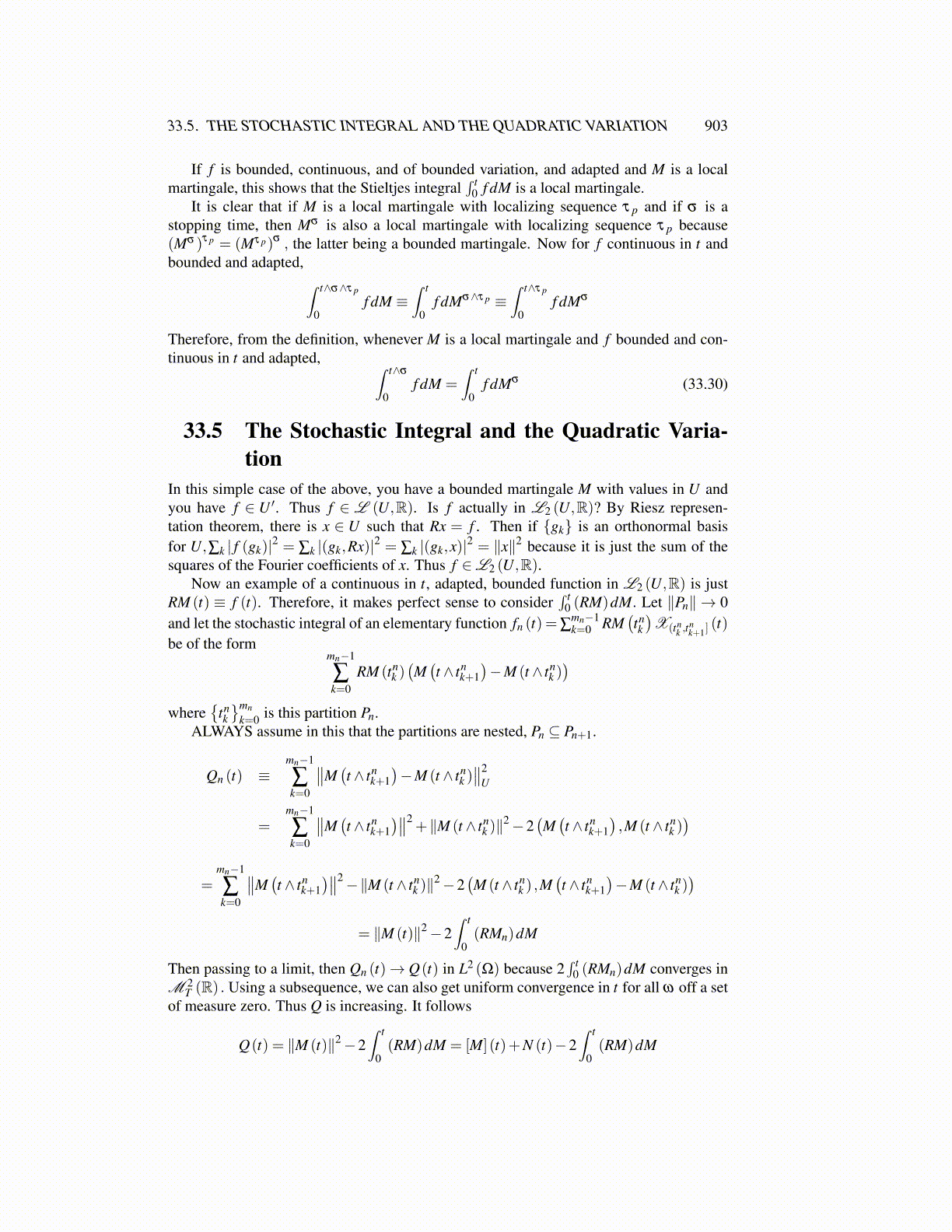
33.5. THE STOCHASTIC INTEGRAL AND THE QUADRATIC VARIATION 903
If f is bounded, continuous, and of bounded variation, and adapted and M is a localmartingale, this shows that the Stieltjes integral
∫ t0 f dM is a local martingale.
It is clear that if M is a local martingale with localizing sequence τ p and if σ is astopping time, then Mσ is also a local martingale with localizing sequence τ p because(Mσ )τ p = (Mτ p)σ , the latter being a bounded martingale. Now for f continuous in t andbounded and adapted, ∫ t∧σ∧τ p
0f dM ≡
∫ t
0f dMσ∧τ p ≡
∫ t∧τ p
0f dMσ
Therefore, from the definition, whenever M is a local martingale and f bounded and con-tinuous in t and adapted, ∫ t∧σ
0f dM =
∫ t
0f dMσ (33.30)
33.5 The Stochastic Integral and the Quadratic Varia-tion
In this simple case of the above, you have a bounded martingale M with values in U andyou have f ∈ U ′. Thus f ∈ L (U,R). Is f actually in L2 (U,R)? By Riesz represen-tation theorem, there is x ∈ U such that Rx = f . Then if {gk} is an orthonormal basisfor U,∑k | f (gk)|2 = ∑k |(gk,Rx)|2 = ∑k |(gk,x)|2 = ∥x∥2 because it is just the sum of thesquares of the Fourier coefficients of x. Thus f ∈L2 (U,R).
Now an example of a continuous in t, adapted, bounded function in L2 (U,R) is justRM (t) ≡ f (t). Therefore, it makes perfect sense to consider
∫ t0 (RM)dM. Let ∥Pn∥ → 0
and let the stochastic integral of an elementary function fn (t) =∑mn−1k=0 RM
(tnk
)X(tn
k ,tnk+1]
(t)be of the form
mn−1
∑k=0
RM (tnk )(M(t ∧ tn
k+1)−M (t ∧ tn
k ))
where{
tnk
}mnk=0 is this partition Pn.
ALWAYS assume in this that the partitions are nested, Pn ⊆ Pn+1.
Qn (t) ≡mn−1
∑k=0
∥∥M(t ∧ tn
k+1)−M (t ∧ tn
k )∥∥2
U
=mn−1
∑k=0
∥∥M(t ∧ tn
k+1)∥∥2
+∥M (t ∧ tnk )∥
2−2(M(t ∧ tn
k+1),M (t ∧ tn
k ))
=mn−1
∑k=0
∥∥M(t ∧ tn
k+1)∥∥2−∥M (t ∧ tn
k )∥2−2
(M (t ∧ tn
k ) ,M(t ∧ tn
k+1)−M (t ∧ tn
k ))
= ∥M (t)∥2−2∫ t
0(RMn)dM
Then passing to a limit, then Qn (t)→ Q(t) in L2 (Ω) because 2∫ t
0 (RMn)dM converges inM 2
T (R) . Using a subsequence, we can also get uniform convergence in t for all ω off a setof measure zero. Thus Q is increasing. It follows
Q(t) = ∥M (t)∥2−2∫ t
0(RM)dM = [M] (t)+N (t)−2
∫ t
0(RM)dM